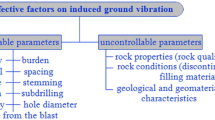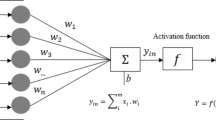Abstract
Due to its technical and economic advantages, the use of explosives in underground rock excavation is widely adopted. However, some safety and, especially, environmental issues arise when using this technique, mainly concerning ground vibrations induced by blasts. Thus, to minimize dynamic environmental impacts, prediction of blast-induced vibrations is imperative. In the last few years, artificial neural networks (ANNs) have been applied to model blast-induced ground vibrations. Nevertheless, ANN’s architecture, mainly the number of neurons in the hidden layer, has been selected manually concerning ANN’s performance parameters. To avoid over-fitting and reduce model’s complexity, this paper presents a bilevel optimization of ANN architecture, considering two transfer functions, based on the maximization of quality of the adjustment and model’s complexity, this last one as a penalty criterion. An ANN approach based on this bilevel optimization was successfully applied on a database of 1188 samples obtained from underground blast-induced ground vibration monitoring in a granitic rock mass. A residual analysis of the best-fitted model is performed to ensure the quality of the adjustment. It is demonstrated that the determined ANN model offers much higher generalization ability than the traditional prediction models usually used for blast-induced ground vibration amplitude predictions and other ANN architectures applied to ground vibration prediction.
Similar content being viewed by others
Explore related subjects
Discover the latest articles, news and stories from top researchers in related subjects.References
Duvall WI, Fogelson DE (1962) Review of criteria for estimating damage to residences from blasting vibrations. U. S. Burreau of Mines, Report of Investigation. vol 5968, p 19
Kumar R, Choudhury D, Bhargava K (2016) Determination of blast-induced ground vibration equations for rocks using mechanical and geological properties. JRMGE 8(3):341–349. https://doi.org/10.1016/j.jrmge.2015.10.009
Görgülü K, Arpaz E, Demirci A, Koçaslan A, Dilmaç MK, Yüksek AG (2013) Investigation of blast-induced ground vibrations in the Tülü boron open pit mine. Bull Eng Geol Environ 72(3–4):555–564. https://doi.org/10.1007/s10064-013-0521-4
Wu YK, Hao H, Zhou YX, Chong K (1998) Propagation characteristics of blast induced shock waves in a jointed rock mass. Soil Dyn Earthq Eng 17(6):407–412. https://doi.org/10.1016/S0267-7261(98)00030-X
Hao H, Wu Y, Ma G, Zhou Y (2001) Characteristics of surface ground motions induced by blasts in jointed rock mass. Soil Dyn Earthq Eng 21(2):85–98. https://doi.org/10.1016/S0267-7261(00)00104-4
Kusumi H, Matsuoka T, Ashida Y, Tatsumi S (2005) Simulation analysis of shear behavior of rock joint by distinct element method. In: Konecny P (ed) EUROCK 2005, impact of human activity on the geological environment. Taylor and Francis, London
Nicholls HR, Johnson CF, Duvall WI (1971) Blasting vibrations and their effects on structures, vol 656. U.S. Department of the Interior, Bureau of Mines, Bull
Ak H, Konuk A (2008) The effect of discontinuity frequency on ground vibrations produced from bench blasting: a case study. Soil Dyn Earthq Eng 28(9):686–694. https://doi.org/10.1016/j.soildyn.2007.11.006
Nateghi R (2011) Prediction of ground vibration level induced by blasting at different rock units. Int J Rock Mech Min Sci 48(6):899–908. https://doi.org/10.1016/j.ijrmms.2011.04.014
Bieniawski ZT (1989) Engineering rock mass classifications: a complete manual for engineers and geologists in mining, civil, and petroleum engineering. Wiley-Interscience, Hoboken
Kuzu C (2008) The mitigation of the vibration effects caused by tunnel blasts in urban areas: a case study in Istanbul. Environ Geol 54:1075–1080. https://doi.org/10.1007/s00254-007-0875-7
Singh TN, Singh V (2005) An intelligent approach to prediction and control ground vibration in mines. Geotech Geol Eng 23(3):249–262. https://doi.org/10.1007/s10706-004-7068-x
Khandelwal M, Singh TN (2007) Evaluation of blast-induced ground vibration predictors. Soil Dyn Earthq Eng 27(2):116–125. https://doi.org/10.1016/j.soildyn.2006.06.004
Khandelwal M, Singh TN (2008) Prediction of blast induced ground vibrations and frequency in opencast mine: a neural network approach. J Sound Vib 289(4–5):711–725. https://doi.org/10.1016/j.jsv.2005.02.044
Khandelwal M, Singh TN (2009) Prediction of blast-induced ground vibration using artificial neural network. Int J Rock Mech Min Sci 46(7):1214–1222. https://doi.org/10.1016/j.ijrmms.2009.03.004
Monjezi M, Ahmadi M, Sheikhan M, Bahrami A, Salimi AR (2010) Predicting blast-induced ground vibration using various types of neural networks. Soil Dyn Earthq Eng 30(11):1233–1236. https://doi.org/10.1016/j.soildyn.2010.05.005
Khandelwal M, Kumar DL, Yellishetty M (2011) Application of soft computing to predict blast-induced- ground vibration. Eng Comput 27(2):117–125. https://doi.org/10.1007/s00366-009-0157-y
Dehghani H, Ataee-pour M (2011) Development of a model to predict peak particle velocity in a blasting operation. Int J Rock Mech Min Sci 48(1):51–58. https://doi.org/10.1016/j.ijrmms.2010.08.005
Verma AK, Singh TN (2011) Intelligent systems for ground vibration measurement: a comparative study. Eng Comput 27(3):225–233. https://doi.org/10.1007/s00366-010-0193-7
Monjezi M, Ghafurikalajahi M, Bahrami A (2011) Prediction of blast-induced ground vibration using artificial neural networks. Tunn Undergr Space Technol 26(1):46–50. https://doi.org/10.1016/j.tust.2010.05.002
Khandelwal M (2012) Application of an expert system for the assessment of blast vibration. Geotech Geol Eng 30(1):205–217. https://doi.org/10.1007/s10706-011-9463-4
Álvarez-Vigil AE, González-Nicieza C, Gayarre FL, Álvarez-Fernândez MI (2012) Predicting blasting propagation velocity and vibration frequency using artificial neural networks. Int J Rock Mech Min Sci 55:108–116. https://doi.org/10.1016/j.ijrmms.2012.05.002
Tiile, RN (2016) Artificial neural network approach to predict blast-induced ground vibration, airblast and rock fragmentation. A Thesis Presented to the Faculty of the Graduate School of the Missouri University of Science and Technology
Paneiro G, Durão FO, Costa e Silva M, Falcão Neves P (2016). Artificial neural network model for ground vibration amplitudes prediction due to light railway traffic in urban areas. Transport Res D-Tr E. https://doi.org/10.1007/s00521-016-2625-9
Beale MH, Hagen MT, Demuth HB (2015) Neural network toolbox™ user’s guide. The MathWorks Inc, Natick
Siskid D, Stagg MS, Kopp JW, Dowding CH (1980) Structure response produced by ground vibration from surface mine blasting. U.S. Bureau of Mines report RI 8507
Jaeger JC, Cook N, Zimmerman RW (2007) Fundamentals of rock mechanics. Blackwell, London
Dinis da Gama C (2013). Unifying energetic approach for the control of ground vibration. In: Kwasniewsky M, Lydzba D (Eds) Rock mechanics for resources, energy and environment. CRC Press. pp 727–732. http://dx.doi.org/10.1201/b15683-124, (ISBN: 978-1-138-00080-3)
Ju SH (2007) Finite element analysis of structure-borne vibration from high-speed train. Soil Dyn Earthq Eng 27(3):259–273. https://doi.org/10.1016/j.soildyn.2006.06.006
Kutner, MH, Nachtsheim CJ, Neter J, Li W (2005). Applied linear statistical models. Fifth Edition. McGraw-Hill Irwin
Draper NR, Smith H (1998) Applied regression analysis, 3rd edn. Wiley Interscience, Hoboken
MacKay DJC (1991) Bayesian methods for adaptive models. Ph.D. thesis, California Institute of Technology
Luke S (2013) Essentials of metaheuristics. Lulu. http://cs.gmu.edu/*sean/book/metaheuristics/. (ISBN 978-0-557-14859-2)
Thomas FE, Himmelblau DM, Lasdon LS (2001) Optimization of chemical processes. McGraw-Hill, New York
Locatelli M, Schoen F (1999) Random Linkage: a family of acceptance/rejection algorithms for global optimization. MathProg 85:379–396. https://doi.org/10.1007/s101070050062
Rinnooy AHGK, Timmer GT (1989) Global optimization. In: Nemhauser GL et al (eds) Handbooks in OR and MS, vol 1. Elsevier, Amsterdam
Rinnooy AHGK, Timmer GT (1987) Stochastic global optimization methods, part 2: multi level methods. Math Prog 39:57–78. https://doi.org/10.1007/bf02592071
Dempe S (2002) Foundations of bilevel programming. Kluwer Academic Publishers, Dordrecht
Rardin Ronald (2017) Optimization in operations research, 2nd edn. Pearson, London
Nocedal J, Wright SJ (2006) Numerical optimization, 2nd edn. Springer, Berlin
Biegler LT (2010) Nonlinear programming concepts, algorithms, and applications to chemical processes, SIAM
Little RJ, Donald R (2002) Statistical analysis with missing data. Wiley, Hoboken
Enders C (2002) Applied missing data analysis. Guilford Press, New York
Ambraseys NR, Hendron AJ (1968) Dynamic behavior of rock masses. In: Stagg KG, Zienkiewiez OC (eds) Rock mechanics in engineering practices. Willey, London
Langefors U, Kihlström B (1978) The modern technique of rock blasting. 3rd edn. Stockholm, Sweden
IS 6922 (1973) Criteria for safety and design of structure subject to underground blast. Bureau of Indian Standards, New Delhi, India
Acknowledgements
The authors would like to thank the editors and reviewing team for their contributions/suggestions.
Author information
Authors and Affiliations
Corresponding author
Ethics declarations
Conflict of interest
The authors declare that there is no conflict of interest regarding the publication of this paper.
Additional information
Publisher's Note
Springer Nature remains neutral with regard to jurisdictional claims in published maps and institutional affiliations.
Rights and permissions
About this article
Cite this article
Paneiro, G., Durão, F.O., Costa e Silva, M. et al. Neural network approach based on a bilevel optimization for the prediction of underground blast-induced ground vibration amplitudes. Neural Comput & Applic 32, 5975–5987 (2020). https://doi.org/10.1007/s00521-019-04083-2
Received:
Accepted:
Published:
Issue Date:
DOI: https://doi.org/10.1007/s00521-019-04083-2














